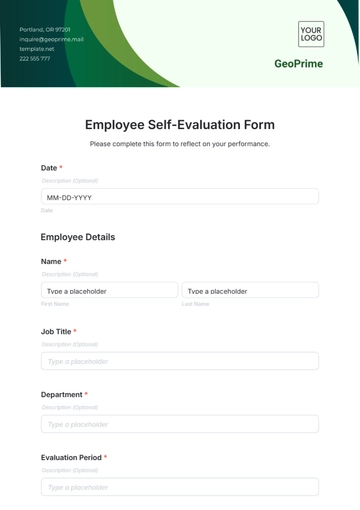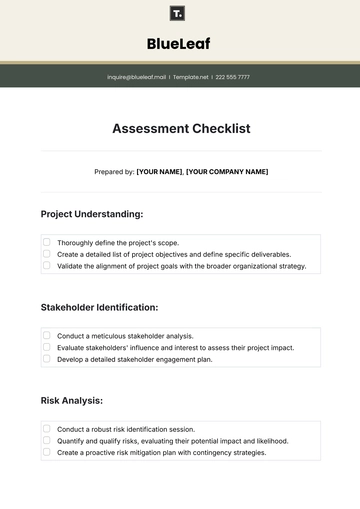Free Procurement Risk Assessment

I. Introduction
This Procurement Risk Assessment aims to identify, evaluate, and mitigate potential risks associated with the procurement process for the upcoming acquisition of goods and services. The objective is to ensure that procurement activities align with organizational goals while managing possible financial, operational, and reputational threats. This assessment will cover various stages of procurement, including supplier selection, contract negotiation, and delivery phases.
II. Risk Identification
The first step in the procurement risk assessment is identifying risks that may impact the procurement process. Below are the most critical risks identified:
A. Supplier Risks
Supplier Reliability: Risks associated with the ability of the supplier to meet delivery schedules, maintain quality, and provide the necessary goods or services.
Financial Stability: The risk that a supplier may face financial difficulties, potentially leading to business failure or delivery delays.
Reputation Risks: Supplier’s reputation, which may influence the buyer’s brand image and customer trust if the supplier's practices are not ethical or sustainable.
B. Financial Risks
Price Volatility: The risk of sudden price changes that can lead to budget overruns and contract disputes.
Currency Fluctuations: For international procurement, exchange rate variations can impact the final cost of goods or services.
C. Legal and Compliance Risks
Regulatory Compliance: Ensuring that procurement complies with local, national, and international laws, including environmental regulations, labor laws, and industry-specific standards.
Contractual Obligations: Risks arising from poorly drafted contracts, unclear terms, or failure to meet contract specifications.
D. Operational Risks
Supply Chain Disruptions: Unforeseen events (e.g., natural disasters, geopolitical issues) that disrupt the supply chain, leading to delays and operational halts.
Quality Assurance: The risk that the procured goods or services do not meet quality standards, affecting the project's overall success.
III. Risk Analysis
After identifying risks, each one is assessed based on its likelihood and impact to determine priority. The assessment uses a Risk Matrix to assign each risk a score for severity:
Risk Type | Likelihood | Impact | Risk Level |
|---|---|---|---|
Supplier Reliability | High | High | Critical |
Price Volatility | Medium | High | Moderate |
Regulatory Compliance | Low | High | Moderate |
Operational Risks | Medium | Medium | Moderate |
Each risk is prioritized to ensure resources are allocated effectively for mitigation.
IV. Mitigation Strategies
The following strategies will be implemented to mitigate the identified risks:
A. Supplier Risks
Supplier Selection Process: A thorough vetting process, including financial health checks, reputation evaluation, and on-site visits, will be implemented to select reliable suppliers.
Supplier Contracts: Contracts will include performance guarantees, penalties for non-compliance, and a clear escalation procedure for resolving disputes.
B. Financial Risks
Fixed Price Agreements: Where possible, fixed-price contracts will be negotiated to avoid price volatility.
Currency Hedging: For international purchases, currency hedging strategies will be considered to mitigate exchange rate fluctuations.
C. Legal and Compliance Risks
Compliance Audits: Regular audits will be conducted to ensure all procurement activities meet local and international regulatory standards.
Clear Contract Terms: Contracts will be reviewed by legal teams to ensure that terms are clear, enforceable, and cover all potential legal issues.
D. Operational Risks
Contingency Plans: Contingency plans, including alternative suppliers and transportation routes, will be developed to manage potential disruptions in the supply chain.
Quality Assurance Testing: Rigorous quality checks and testing will be conducted before goods are shipped, ensuring they meet the required standards.
V. Monitoring and Review
To ensure the effectiveness of risk mitigation strategies, continuous monitoring will be implemented through the following measures:
A. Ongoing Supplier Evaluation
Supplier performance will be monitored regularly, including delivery times, quality of goods, and adherence to contract terms.
B. Risk Review Meetings
Monthly procurement risk review meetings will be held to assess new risks, evaluate the effectiveness of current mitigation strategies, and update the risk assessment as needed.
C. Audits and Reporting
Regular audits will ensure compliance with procurement policies, regulations, and contractual obligations. Reports will be generated and reviewed by senior management.
VI. Conclusion
This Procurement Risk Assessment highlights several critical risks related to supplier selection, financial volatility, legal compliance, and operational disruptions. By implementing robust mitigation strategies, such as thorough supplier vetting, fixed-price contracts, and contingency planning, we aim to minimize these risks and ensure the success of the procurement process. Continuous monitoring and regular reviews will further help in managing emerging risks and ensuring ongoing compliance and efficiency.
VII. Appendices
A. Risk Matrix
A detailed risk matrix is provided, listing each identified risk along with its likelihood, impact, and mitigation actions.
B. Supplier Evaluation Checklist
This checklist outlines the criteria used for evaluating potential suppliers, including financial stability, reputation, and past performance.
C. Compliance and Regulatory Guidelines
A document containing relevant compliance and regulatory standards that must be adhered to during procurement.
- 100% Customizable, free editor
- Access 1 Million+ Templates, photo’s & graphics
- Download or share as a template
- Click and replace photos, graphics, text, backgrounds
- Resize, crop, AI write & more
- Access advanced editor
Proactively identify and address potential challenges with the Procurement Risk Assessment Template from Template.net. This editable and customizable tool simplifies risk evaluation, enabling you to pinpoint vulnerabilities and develop mitigation strategies. Editable in our Ai Editor Tool, the template is perfect for tailoring risk management approaches to meet your organization's specific procurement needs, ensuring effective and secure decision-making.





























